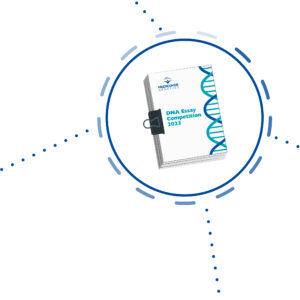Pancreatic cancer has the lowest survival rate of all cancers and is the 4th most common cause of cancer death. In early stages, malignant neoplasms of the pancreas often cause no symptoms or only unspecific symptoms so that the tumor is often detected late. As a result, the relative 5-year survival rate is about 8% for both men and women.
Over 95% of pancreatic malignancies are ductal adenocarcinomas caused by degeneration of the exocrine part of the pancreas. Exocrine pancreatic carcinoma develops mainly from premalignant precursors of the epithelium in the pancreatic duct (PanIN, pancreatic intraepithelial neoplasia).
In addition, mucus-forming, cystic lesions such as mucinous cystic neoplasms (MCN) and intraductal papillary mucinous neoplasms (IPMN) are also considered precancerous leading to invasive pancreatic cancer.
GENOMIC ALTERATIONS
The progression from ductal epithelial cell dysplasia to adenocarcinoma is biologically characterized by the accumulation of a variety of genetic and epigenetic aberrations. The most common genetic aberrations are variants in the KRAS oncogene which are detected in >90% of patients (mostly Gly12Asp or Gly12Val in exon 2) and are considered to be initial oncogenic changes. As disease progresses, variants in the tumor suppressor genes CDKN2A, TP53 (in >80%) and SMAD4 (40-50%) may occur.
For differential diagnostic classification, cystic fluid or pancreatic secretion is used for molecular genetic analysis. Modern high-throughput screening techniques have shown that, especially in IPMN, entity specific genetic alterations are present in the cystic fluid. Thus, variants in GNAS are only described in IPMN (41-66%) and not in MCN, SCA or solid pseudopapillary neoplasms. A molecular genetic analysis of KRAS and GNAS can therefore be used as a building block in the preoperative diagnosis of these tumors. The simultaneous determination of protein-based tumor markers, in particular carcinoembryonic antigen, further increases the sensitivity of this investigation while maintaining the same high specificity.
POSSIBLE THERAPIES
Where information about the tumor is available, the KRAS status in the tumor also allows prognostic and predictive statements. Patients with KRAS wild-type status in the tumor material showed a clinically more favorable course in several studies. However, more than 90% of patients have KRAS variants which, together with other factors, lead to an immunosuppressive environment and explains why T-cell targeted therapies such as CTLA4 or PD-L1 blockers have so far remained largely ineffective. The same is true for SMAD4 status, where wild-type status is also associated with a less aggressive clinical course, although some studies also showed that the loss of SMAD4 expression is associated with a better response to adjuvant chemotherapy. SMAD4 could thus also serve as a predictive biomarker.
Another predictive biomarker is hENT1 expression in tumor tissue. hENT1 is crucial for the uptake of the chemotherapeutic agent gemcitabine into tumor cells. Patients with high hENT1 expression responded significantly better to therapy with gemcitabine. Similar data were obtained for the expression of the protein SPARC (osteonectin1), which is detected in the tumor stroma particularly and correlates with a worse prognosis. SPARC is the receptor for another chemotherapeutic agent—nab-paclitaxel. Patients with high SPARC expression in the tumor stroma seem to benefit more from this therapy than those with low SPARC expression. Germline variants have also been shown to be a predictive marker for therapy response. For example, patients with germline variants in BRCA1/2, which lead to a deficiency in DNA repair, respond better to platinum-based therapy regimens. According to the latest data from the POLO study, patients with metastatic, platinum-sensitive pancreatic cancer and germline BRCA1/2 variants also show significantly prolonged progression-free survival under maintenance therapy with the PARP inhibitor olaparib. About 5% to 7% of all patients with pancreatic cancer, especially those affected at a young age, are carriers of a germline variant. In order to therapeutically target the much larger collective of pancreatic tumors, studies are currently investigating treatment approaches with epigenetic therapeutics such as HDAC and EZH2 inhibitors in combination with immunotherapy and chemotherapy.
GENE PANEL
27 genes: ALK, APC, ATM, BRAF, BRCA1, BRCA2, CDKN2A, ERBB2, FANCC, FANCG, GNAS, KRAS, MDM2, MLH1, MSH2, MSH6, NTRK1, NTRK2, NTRK3, PALB2, PIK3CA, PMS2, RET, ROS1, SMAD4, STK11, TP53
FUSION GENE PANEL
EWSR1-FLI1, GATM-BRAF, HACL1-RAF1, HERPUD1-BRAF, SND1-BRAF, ZSCAN30-BRAF
TARGETED PANEL
BRAF, BRCA1, BRCA2, KRAS, PALB2, SMAD4, NTRK1/2/3 fusion, MSI





















